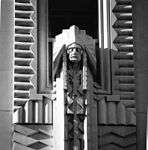Eliel Saarinen
| Gottlieb Eliel Saarinen | |
|---|---|
 Eliel Saarinen | |
| Born |
August 20, 1873 Rantasalmi, Grand Duchy of Finland, Russian Empire |
| Died |
July 1, 1950 (aged 76) Bloomfield Hills, Michigan, United States |
| Nationality | Finnish |
| Occupation | Architect |
| Awards | AIA Gold Medal |
| Buildings |
Helsinki Central railway station |
| Projects | Finnish pavilion at the World Fair of 1900 |
| Design | Finnish markka banknotes introduced in 1922 |
Gottlieb Eliel Saarinen (Finnish pronunciation: [ˈeliel ˈsɑːrinen]; August 20, 1873 – July 1, 1950) was a Finnish architect known for his work with art nouveau buildings in the early years of the 20th century. He was the father of Eero Saarinen.
Life and work in Finland
Saarinen was educated in Helsinki at the Helsinki University of Technology. From 1896 to 1905 he worked as a partner with Herman Gesellius and Armas Lindgren at the firm Gesellius, Lindgren, and Saarinen. His first major work with the firm, the Finnish pavilion at the World Fair of 1900, exhibited an extraordinary convergence of stylistic influences: Finnish wooden architecture, the British Gothic Revival, and the Jugendstil. Saarinen's early manner was later christened the Finnish National Romanticism and culminated in the Helsinki Central railway station (designed 1904, constructed 1910-14). Between 1902 and 1912, he was also co-author of the design for the Fennia series, produced by Arabia pottery.
From 1910 to 1915 he worked on the extensive city-planning project of Munksnäs-Haga and later published a book on the subject. In January 1911 he became a consultant in city planning for Reval, Estonia and was invited to Budapest to advise in city development. In 1912, a brochure written by Saarinen about the planning problems of Budapest was published. In April 1913 he received the first place award in an international competition for his plan of Reval. From 1917 to 1918 Saarinen worked on the city-plan for greater Helsinki. He also designed a series of postage stamps issued 1917 and the Finnish markka banknotes introduced in 1922.
After the divorce from his first wife, Mathilde (who then married Herman Gesellius), on March 6, 1904 Saarinen married his second wife, Louise (Loja) Gesellius, a sculptor in Helsinki, and the younger sister of Herman Gesellius. They had a daughter Eva-Lisa (Pipsan) on March 31, 1905 and a son Eero on August 20, 1910.
Move to the United States
Eliel Saarinen moved to the United States in 1923 after his noted competition entry for the Tribune Tower in Chicago, Illinois. Although Saarinen's entry won second place it was not built; the most faithful realization of it is the 1929 Gulf Building in Houston. Saarinen first settled in Evanston, Illinois, where he worked on his scheme for the development of the Chicago lake front. In 1924 he became a visiting professor at the University of Michigan.
In 1925 George Gough Booth asked him to design the campus of Cranbrook Educational Community, intended to be an American equivalent to the Bauhaus. Saarinen taught there and became president of the Cranbrook Academy of Art in 1932. Among his student-collaborators were Ray Eames (then Ray Kaiser) and Charles Eames; Saarinen influenced their subsequent furniture design.
He became a professor in the University of Michigan's Architecture Department. When she was appointed dean of Taubman College of Architecture and Urban Planning at the University of Michigan, Monica Ponce de Leon, was honored with the Eliel Saarinen Collegiate Professorship.
His son, Eero (1910–1961), became one of the most important American architects of the mid-20th century, as one of the leaders of the International style. Saarinen's student Edmund N. Bacon achieved national prominence as Executive Director of the Philadelphia City Planning Commission from 1949 to 1970.
He received the AIA Gold Medal in 1947.
Significant works
| Work | Location | Finished | Picture |
|---|---|---|---|
| Finnish Pavilion at the Exposition Universelle | Paris | 1900 |  |
| Hvitträsk | Kirkkonummi | 1902 | |
| National Museum of Finland | Helsinki | 1904 |  |
| Helsinki Central railway station | Helsinki | 1909 | |
| Lahti Town Hall | Lahti | 1911 | |
| Vyborg railway station | Vyborg | 1913 | |
| Joensuu Town Hall | Joensuu | 1914 | |
| Saint Paul's Church | Tartu | 1917 | |
| Marble Palace | Helsinki | 1918 | |
| Munkkiniemi Pension house | Helsinki | 1920 | |
| Kleinhans Music Hall | Buffalo | 1940 | |
| Crow Island School | Winnetka | 1940-41 | |
| First Christian Church | Columbus | 1942 |  |
| Cranbrook Educational Community | Bloomfield Hills | 1940's | |
| Des Moines Art Center | Des Moines | 1948 | |
| Christ Church Lutheran | Minneapolis | 1949 |  |
References and further reading
- Saarinen, Eliel (1985). The search for form in art and architecture. New York: Dover.
- Saarinen, Eliel (1943). The City: Its Growth, its decay, its future. New York: Reinhold publishing corporation.
- Hausen, Marika (ed) (1984). Eliel Saarinen: 1873-1950 - Works in Finland. Helsinki: Museum of Finnish Architecture.
- A&E with Richard Guy Wilson, Ph.D.,(2000). America's Castles: Newspaper Moguls, Pittock Mansion, Cranbrook House & Gardens, The American Swedish Institute. A&E Television Network.
- Hill, Eric J. and John Gallagher (2002). AIA Detroit: The American Institute of Architects Guide to Detroit Architecture. Wayne State University Press. ISBN 0-8143-3120-3.
- Pelkonen, Eeva-Liisa (2006). Eero Saarinen. New Haven: Yale University Press. ISBN 0-300-11282-3.
External links
| Wikimedia Commons has media related to Eliel Saarinen. |
- Eliel Saarinen at the archINFORM database.

